Verzeichnete Spur
max8-2018
Matthias Pintscher
Outline
action
Updated at
Do you notice a mistake?
The setup and the execution of the electroacoustic part of this work requires a Computer Music Designer (Max expert).
Version Information
- Performance date
- January 20, 2018
- Documentation date
- February 6, 2019
- Version
- max8-2018
- Status
- valid
- Validation date
- May 16, 2020
- Documentalist
- Benoit Meudic (Benoit.Meudic@ircam.fr)
- Length
- 20 min
- Upgrade motivation
- Version max 8 Spatialisation added and revision with Matthias Pintscher
Other Versions
agora-cite-de-la-musiquearchivedJune 29, 2010
Detailed Staff
- Soloist
- double bass, 3 cellos
harp, piano, bass clarinet, contrabass clarinet, 3 percussionists
Detailed staff comes from Brahms, send mail to ressources-contenus@ircam.fr for correction.
Electronic Equipment List
Audio Equipment
- 1 Lexicon 300
- Effects Processor (Lexicon) - for amplification
- 6 Loudspeaker
- Loudspeakers (generic)
- 1 Microphone
- Microphone (generic) - for all instruments
Computer Music Equipment
- 1 Sound Board
- Sound Board (generic)
- 1 Footswitch / Sustain Pedal
- Footswitch / Sustain Pedal (generic)
- 1 MacBook Pro
- Apple Laptops (Apple) - MacBook Pro >= 2.7Ghz with os >= 10.12.16
- 1 iPad
- Tablets (Apple) - iPad for mixing
- 1 antescofo~
- External objects (Ircam)
- 1 Mira
- Library (Cycling74)
- 1 Max 8
- Max (Cycling74)
Downloads
Verzeichnete Spur 2018.dmg
comment
max patch
2 Go
Verzeichnete Spur 2018-simulation Project.dmg
comment
ableton live session for simulation
959.89 Mo
dsp
84.48 Ko
main-patch
280.86 Ko
midi
78.45 Ko
mira
54.85 Ko
Verzeichnete_Spur
comment
only for computer music designer
8.45 Mo
center
147.21 Ko
Instructions
Description of the piece
Verzeichnete Spur is a piece composed by Matthias Pintscher for double bass, three cellos and live electronics.
It was created in 2005
Elements required to play the piece
- 1 main computer for electronic treatments with at least max 8.1.1 (Mac os >= 12.12.8 & MacBookPro >= 2.7Ghz),
- 4 in/ 6 outs audio interface (for instance RME fireface 800)
- microphones for each instrument
- 1 mixing console
- 6 points full band diffusion system.
- 1 midi sustain pedal for triggering events (double bass player)
- 1 iPad for mixing with mira
General informations:
The electronic part of Verzeichnete Spur is based upon real-time treatments on the instruments: chromax, delays, filters, harmonizers, Iana, granular synthesis, resonators and spatialisation.
An ipad should be used for mixing the electronic treatments and the soundfiles (see faders mapping below).
The events are triggered by the double bass player (sustain pedal with midi connection to the patch).
The event are written in Antescofo language for recalling presets of the effects (file data/scores/VerzeichneteSpur.asco).
MAIN COMPUTER
installation
Copy the folder 'Verzeichnete Spur 2018' on the hard disk of the main computer.
Launch max, and select this folder (and only this one) in the 'file preferences' menu of max.
Open the file '_Verzeichnete Spur 2018' in Max.
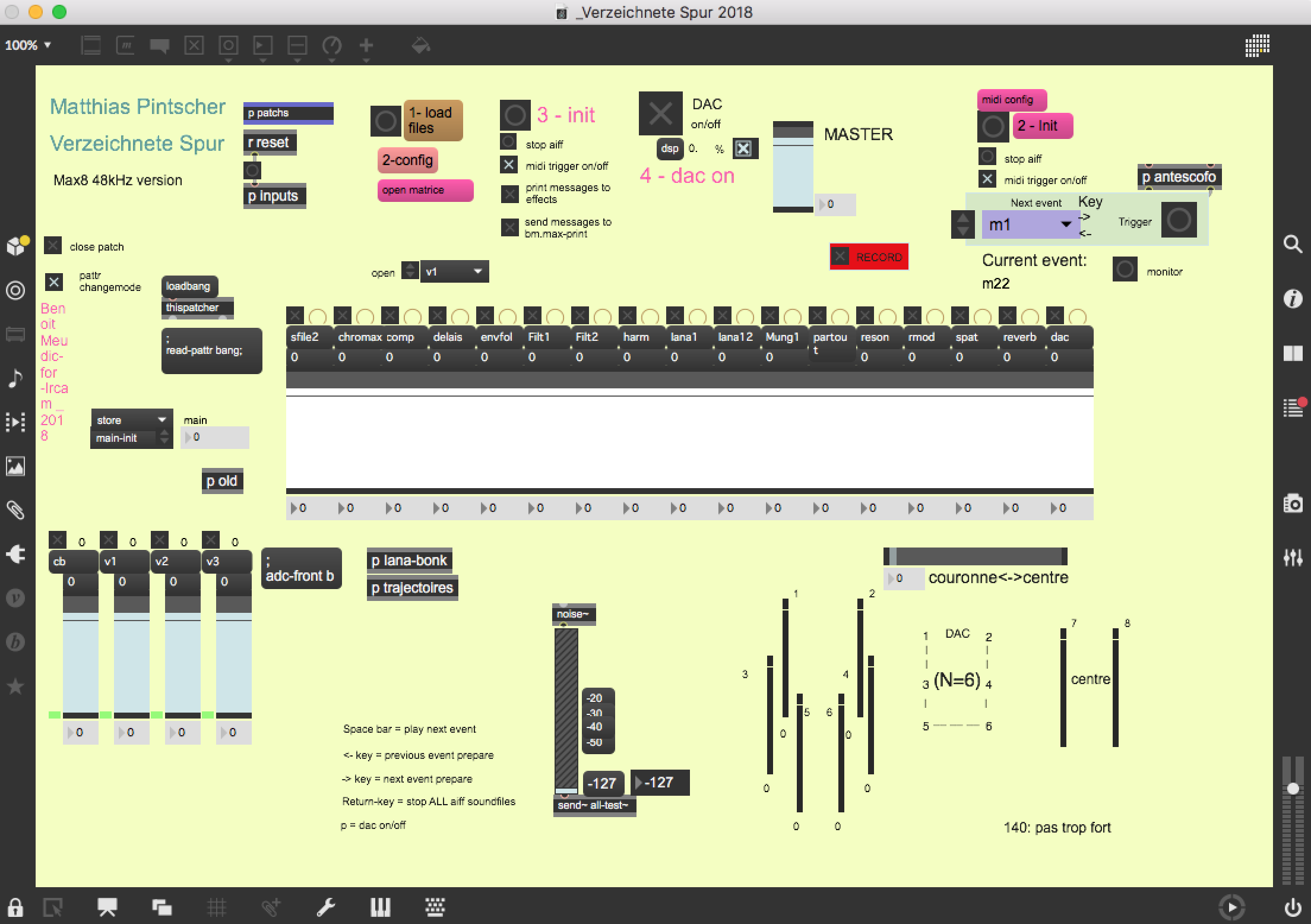
Description (figure 'main-patch')
The concert patch is composed of:
- Top right: interface for events triggering. Events are represented by a number corresponding to the bar number reported in the instrumental score. The highlighted number corresponds to the next event that will be triggered.
- Top middle: main sub-patchers (audio, midi, libraries, events counter, reset, matrix connections).
- Bottom: live mixing faders.
Inputs/Outputs
There are 4 inputs for double bass (cb), cello1 (vc1), cello2 (vc2), cello3 (vc3).
There are 6 outputs: dac 1..6 for loudspeakers 1 front left, 2 front right, 3middle left, 4 middle right, 5 back left and 6 back right
Optionnally tou can also use outputs 7-8 in case of specific venue configuration with a center point (for instance if the audience is around the musicians as it is the case in the 'boulez concert hall' in Berlin. In order to use them you should connect the receive message 'couronne balance' in the patch 'p spat' to the third input of the object 'pan2'. Then the messages 'couronne balance' in the score 'VerzeichneteSpur.asco.txt' can be tuned according to what you want.
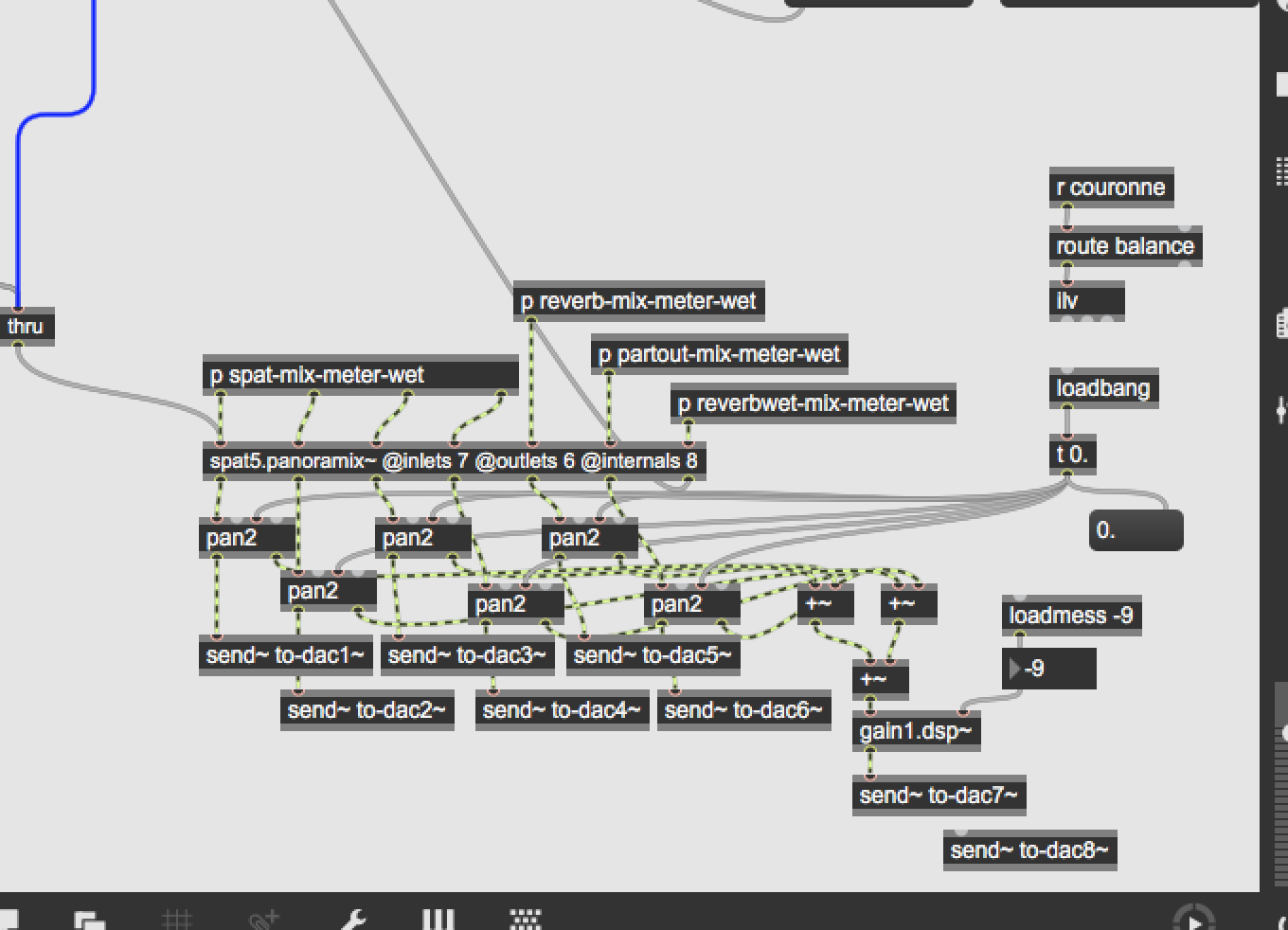
Initialisation in max
To initialize the patch:
1. Click on '1-load files'
2. Click on '2-config' to choose the midi port for the sustain pedal
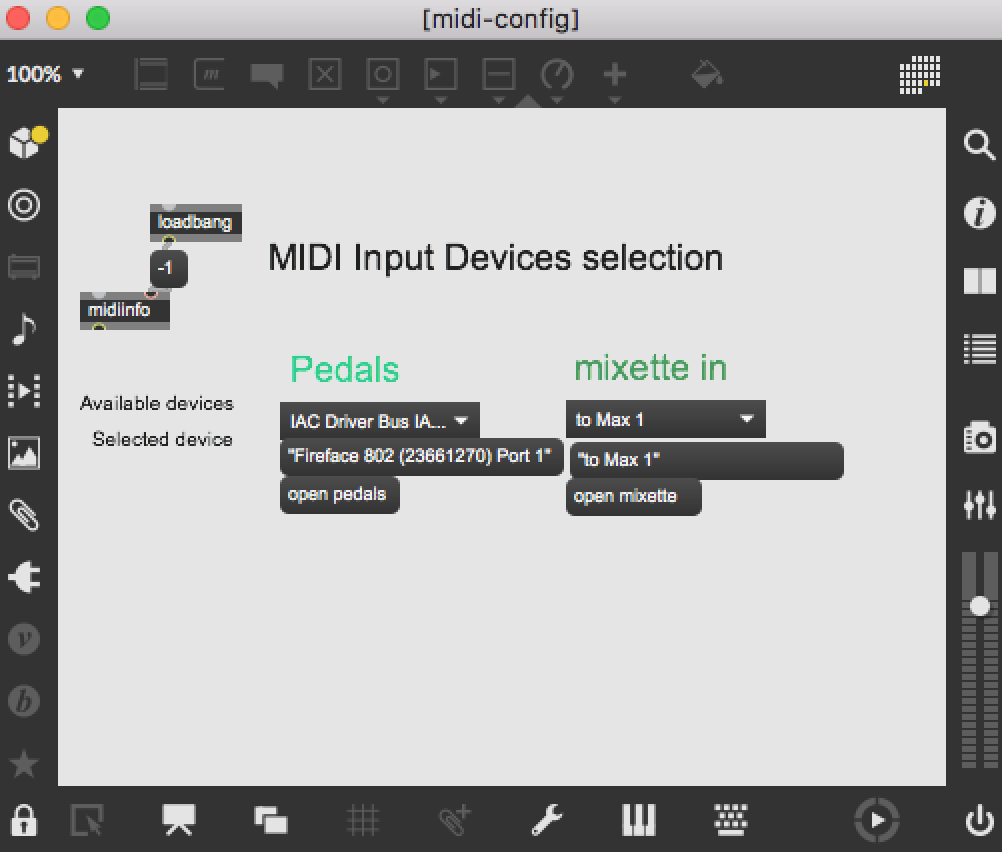
3. click on '3-init' and wait for the message 'ok bang' in the max message window.
The audio status should automatically be set to 256 for I/O Vector Size, 128 for Signal Vector Size, 48000 for sampling rate, overdrive on and audio interrupt off :
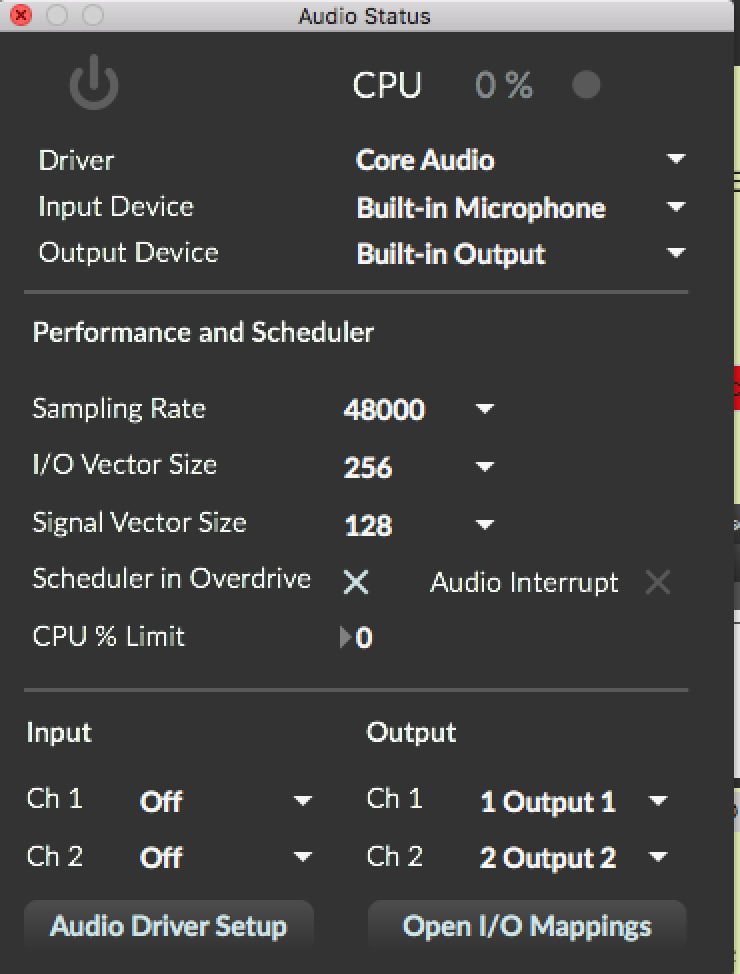
4. turn the DSP on
Keyboard shortcuts: 'space bar' for triggering events, '<-' for going one event back, '->' for gooing one event after, 'return key' for stoping sfiles.
Ipad mixing control:
You can control the patch with an ipad via Mira: control of live mixing faders of sfiles, filter, harmonizer, Iana1, Munger, resonator, reverb, spatialisation and master fader.
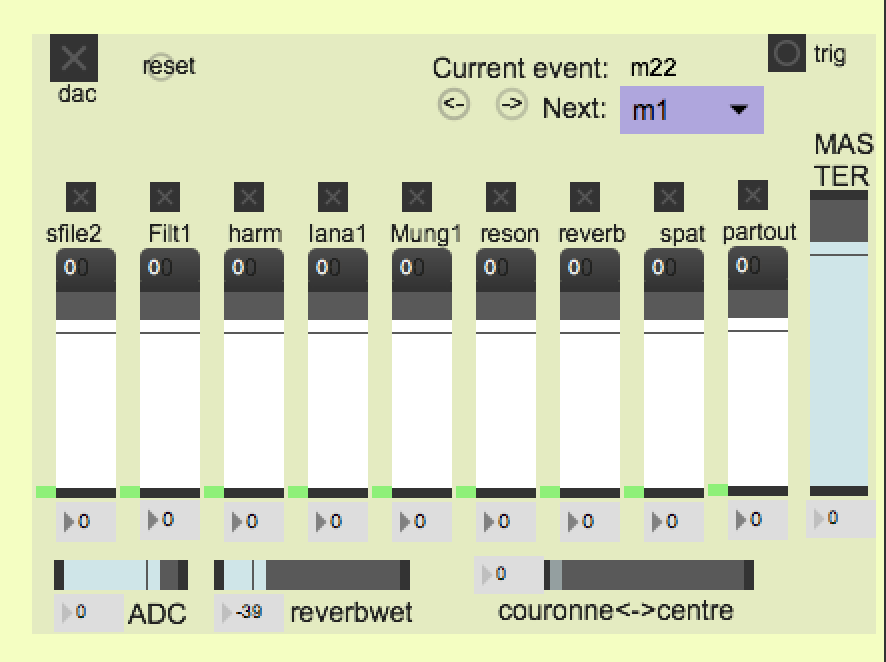
Execution instructions
There should always be quite a lot of reverb on the instruments. The inputs mics sent to the patch should be compressed. Try to reduce also the frequencies that could "feed" feeback (depending on the concert hall).
Input levels of main treatments should be followed during the concert. We should hear each resonnators, but without feedback. Try to make electronic sound natural, as if it was coming from the instruments. 140: not too loud.
Simulation:
You can use the live session 'Verzeichnete Spur 2018-simulation Project' for simulating the input of the instruments. The tracks "*-elec" are only for display, the enveloppes 'param' show the opening of electronic treatments and do not contain sounds.
Updated at
Do you notice a mistake?